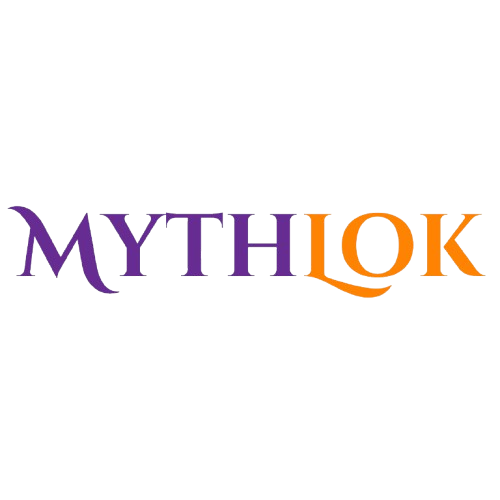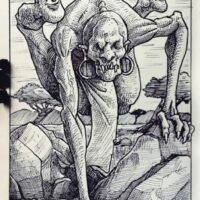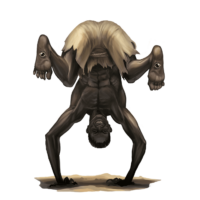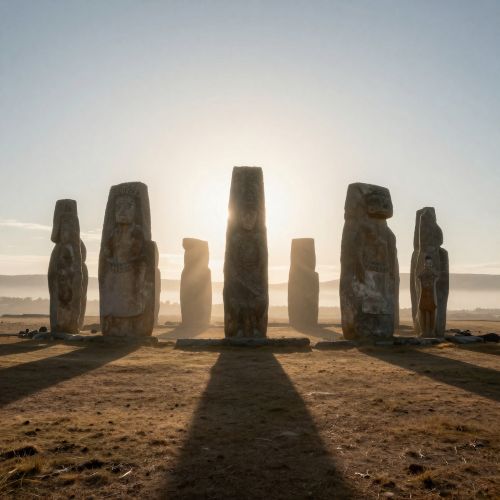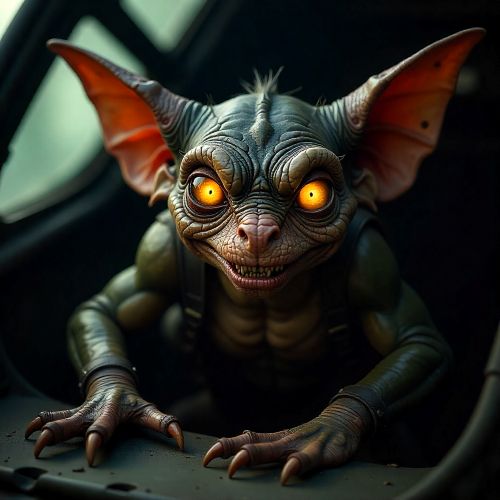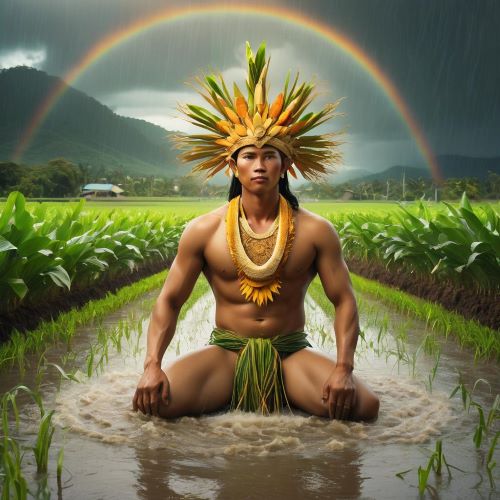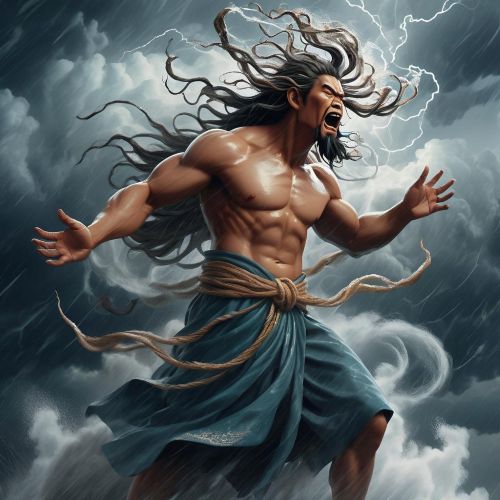Manawbanaw : God of Rain
Listen
At a glance
| Description | |
|---|---|
| Origin | Philippine Mythology |
| Classification | Gods |
| Family Members | Magbabaya (Father), Tagbusan, Mebuyan (Siblings) |
| Region | Philippines |
| Associated With | Rain, Thunder, Taboo, Tattoo |
Manawbanaw
Introduction
Manawbanaw occupies a formidable position in Philippine mythology, particularly in the belief systems of the Manobo people of Mindanao. Revered as the god of rain, thunder, and lightning, he represents both nourishment and discipline. As an enforcer of divine taboos, his wrath is feared and his favor is deeply sought. Among the Manobo, Manawbanaw is not just a bringer of weather but also a spiritual judge. His myth underscores the profound relationship between the natural world and moral order, a connection deeply embedded in the Manobo cosmology. These mythic narratives have survived colonial interventions, maintaining a resilient presence in the oral traditions and sacred rites of the indigenous communities.
Physical Traits
While not extensively described in recorded texts, Manawbanaw’s image emerges from the poetic metaphors and symbols within Manobo stories. He is often imagined as an immense figure cloaked in monsoon clouds, with lightning for eyes and thunder in his voice. His form is not static; it shifts with the weather—sometimes veiled in mist, sometimes flashing brightly across the stormy sky. The metaphor “chief who owns the drooling saliva from his ten tongues” paints him as a force with overwhelming voice and presence. Such imagery supports the notion that he is an entity composed of sound, movement, and atmospheric power rather than human form. In tribal storytelling, Manawbanaw may manifest through natural signs—booming thunder, sudden rainfall, or eerie silence before a storm—each gesture a divine message or warning.
Family
Manawbanaw’s lineage connects him to other prominent deities in Manobo and Bukidnon cosmologies. He is frequently linked with the supreme god Magbabaya, who is believed to have created the universe and its order. In some myths, Manawbanaw is considered a manifestation or an aspect of a god named Dadanhayan ha Suguy, who enforces cosmic law and grants spiritual permissions. These overlapping roles suggest that Manawbanaw functions within a divine hierarchy where he either serves or shares identity with other major gods, acting as a divine intermediary. His association with powerful spirits or creator deities implies that his actions are deeply rooted in cosmic justice, and his punishment is not random but divinely sanctioned. While he may not have direct offspring or a consort explicitly named in the stories, his relational standing within the pantheon highlights a divine network bound by purpose rather than blood.
Other names
Throughout various regions and traditions, Manawbanaw is known by several names that reflect his multifaceted role. As Takinan Manawbanaw, he is addressed as a chieftain figure with divine authority and immense oratorical power. Another title, Dadanhayan ha Suguy, emphasizes his role as a gatekeeper or enforcer from whom permission must be sought before rituals or decisions are made. The name Manewvanew also surfaces, offering phonetic variation that may indicate regional dialect differences rather than distinct identities. These multiple names not only highlight his widespread reverence but also suggest a deity whose presence permeates several aspects of spiritual life, from weather control to moral governance.
Powers and Abilities
Manawbanaw wields elemental authority over rain, thunder, and lightning, shaping both the natural landscape and the spiritual health of his people. He is invoked in times of drought to bring rainfall, an act that nourishes crops and restores ecological balance. Yet he is equally feared, as his fury can manifest in the form of hailstorms or thunderous chaos when taboos are broken. These punishments, often believed to melt into lakes or destroy villages, serve as reminders of the consequences of disobedience to ancestral laws.
His powers go beyond weather; he governs spiritual equilibrium, serving as a divine sentinel who detects and reacts to moral decay. Illness, misfortune, or environmental disaster may be interpreted as signs of his displeasure. This divine intervention positions him as both healer and destroyer—one whose rain can revive dying lands or wash away corrupt intentions. His presence during healing ceremonies, agricultural rites, and tribal gatherings affirms his central role in maintaining both natural and spiritual harmony.
Modern Day Influence
Though centuries of colonization and religious transformation have altered the spiritual landscape of the Philippines, Manawbanaw’s legacy endures. In rural Manobo communities, his name is still uttered during planting festivals, rain-invoking rituals, and chants led by tribal shamans, or bailan. These rituals blend ancient beliefs with modern faiths, forming a syncretic practice where Christian saints and indigenous gods are venerated side by side.
The figure of Manawbanaw has also entered the imagination of contemporary youth, especially within movements that seek to reclaim and preserve indigenous identity. Artists and storytellers reimagine him as a guardian of the environment, symbolizing the balance between human activity and nature’s laws. His myth has found new life in folk music, street theater, and even academic discussions about decolonizing Philippine spirituality.
Moreover, his moral role continues to influence language and thought. In popular culture, phrases invoking storms or thunder often echo ancestral fears and reverence. In times of political unrest, metaphors involving rain and divine punishment are sometimes used to critique corruption, showing how ancient deities like Manawbanaw still serve as cultural reference points for justice and truth.
Related Images
Source
The Aswang Project. (2020, September 12). Mindanao Mythologies & Beliefs. Retrieved from https://www.aswangproject.com/philippine-mythology/mindanao-mythologies-beliefs/page/2/.
The Pinay Writer. (2024, May 7). The Bisayan Deities: Who Were the Gods & Goddesses? Retrieved from https://thepinaywriter.com/the-bisayan-deities-who-were-the-gods-goddesses/.
Yodisphere. (2022, May 17). The Manobo Tribe of the Philippines: History, Culture, Customs and Traditions. Retrieved from https://www.yodisphere.com/2022/05/Manobo-Tribe-History-Culture-Traditions.html.
Ramos, M. D. (1991). On the Limits of the “Thunder Complex” in Australasia. A Reply to Gregory Forth. Philippine Quarterly of Culture and Society, 19(4), 319-322.
Scott, W. H. (1994). The Bukidnon myths of sickness, death and afterlife. Philippine Studies, 42(3), 362-381.
Frequently Asked Questions
What is lorem Ipsum?
I am text block. Click edit button to change this text. Lorem ipsum dolor sit amet, consectetur adipiscing elit. Ut elit tellus, luctus nec ullamcorper mattis, pulvinar dapibus leo.
What is lorem Ipsum?
I am text block. Click edit button to change this text. Lorem ipsum dolor sit amet, consectetur adipiscing elit. Ut elit tellus, luctus nec ullamcorper mattis, pulvinar dapibus leo.
What is lorem Ipsum?
I am text block. Click edit button to change this text. Lorem ipsum dolor sit amet, consectetur adipiscing elit. Ut elit tellus, luctus nec ullamcorper mattis, pulvinar dapibus leo.
What is lorem Ipsum?
I am text block. Click edit button to change this text. Lorem ipsum dolor sit amet, consectetur adipiscing elit. Ut elit tellus, luctus nec ullamcorper mattis, pulvinar dapibus leo.
What is lorem Ipsum?
I am text block. Click edit button to change this text. Lorem ipsum dolor sit amet, consectetur adipiscing elit. Ut elit tellus, luctus nec ullamcorper mattis, pulvinar dapibus leo.

